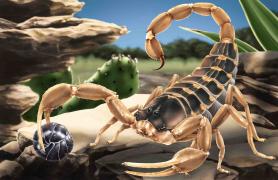
Imagine you’re a carpenter ant, exploring the base of a tree. You crawl over a moss-covered vine and follow it up the trunk, searching for a better view. Suddenly, two gleaming black daggers rip out of the vine and stab you in the belly! As everything goes dark, your last thought is: “What in the world just happened?”
Fang You Very Much
If you’re lucky enough to find a purseweb spider outside its dirty sock, you might notice the tomato-red legs of a boy or the fuzzy, chocolate-brown abdomen of a girl. You might take note of its size: Girl pursewebs are a little larger than a quarter coin; boys are slightly smaller. But one thing you’d definitely spot is its ginormous black fangs.
A purseweb’s impressive fangs can measure over a third of its overall body length. (Imagine if your teeth were longer than your head!) But despite its scary, vampire-like appearance, pursewebs are shy and gentle, and they avoid using their fangs unless they feel threatened.
Or unless they get hungry, of course.
Life in a Dirty Sock
Missouri has about 400 kinds of spiders, but not all of them spin delicate, beautiful webs. Red-legged purseweb spiders, for example, build tough silken tubes that look like dirty socks.
The tubes climb up the trunks of trees about 6 to 12 inches and extend underground a short distance. Sneaky spiders disguise their tubes with bits of soil from their burrows. Over time, mosses and lichens may grow on the tubes, making them look like innocent vines clinging to tree trunks.
Purseweb spiders spend nearly their entire lives in these hidden homes. Girl spiders rarely, if ever, venture outside. Boys leave their homes only to search for mates — and then never return. The tubes protect the spiders from weather and hide them from predators. They also serve as nearly invisible hunting blinds.
Visitors Beware!
A purseweb’s tube is attached to the tree only at the top end. It hangs down the trunk and vibrates like a guitar string whenever something disturbs it.
If an insect crawls over its home, the spider feels the bug’s footsteps from deep inside its burrow. It rushes up the tube and stabs its fangs through the silk wall into the insect. Surprise!
Venom quickly paralyzes the prey. Once the bug stops struggling, the spider slices a slit in the tube and drags its dinner inside. The venom turns the insect’s insides to mush, and the spider sucks it up like a bug-flavored protein shake. Mmmm, yummy!
Using the same sock as your butcher shop, kitchen, and dining room could create a house-keeping disaster. But pursewebs take out their trash. When dinner is done, the spider stitches up the tear in the side of its tube and tosses the dried-up shells of its prey out the top. Some of the remains stick to the sides of the sock. Others pile up at the base.
Dangerous Dating
In June, male pursewebs search for mates. But leaving the safety of the sock is dangerous. Predators such as birds, reptiles, and other spiders would love to make a meal out of a meaty purseweb.
Luckily, the lovesick spider has a trick up its sleeve — or, rather, its legs. Having a shiny black body and eight red appendages makes it look, at first glance, like a wasp. Since getting stung isn’t on many predators’ to-do lists, most give the look-alike spider plenty of space.
The male zigzags across the forest floor, following a trail of scents to a female’s home tube. Once he gets there, he’ll either meet his mate or have the worst day of his life. If the female is hungry, already has a boyfriend, or is just in a bad mood, she’ll eat him.
He taps on the tube in a way he hopes will convince the larger female he isn’t prey. If she lets him in, the male lives in her burrow for several months until he dies of old age. Then the female eats him anyway. Spiders, you see, aren’t sentimental.
Baby Balloons
After meeting her mate, the female lays 50 to 140 eggs, wraps them tightly in a blanket of silk, and hangs the sac on the wall of her burrow. The baby spiders, which look like itty-bitty adults, hatch later in the summer.
Biologists aren’t sure what happens after that. Some think that the spiderlings spend winter with mom and leave the following spring. Others think they climb out of the tube in the fall, a few weeks after they hatch.
Once they leave, the youngsters probably crawl to a high perch and hang off of it by a strand of silk, like a mountain climber rappelling down a cliff. Whoosh! The silk strand catches the wind and launches the spider into the air like a tiny, eight-legged balloon. Whee!
The wind scatters the babies across the forest. Once they land, they get to work building dirty socks that will become, with luck, homes for a new generation of hidden hunters.








Also In This Issue

Plier-like pincers on the front of a scorpion clamp down on spiders, insects, and other prey.

Mysterious and misunderstood, bats are Missouri’s furriest and most fascinating flyers.
And More...
This Issue's Staff
Photographer – Noppadol Paothong
Photographer – David Stonner
Designer – Marci Porter
Designer – Les Fortenberry
Art Director – Cliff White
Editor – Matt Seek
Subscriptions – Laura Scheuler
Magazine Manager – Stephanie Thurber






















